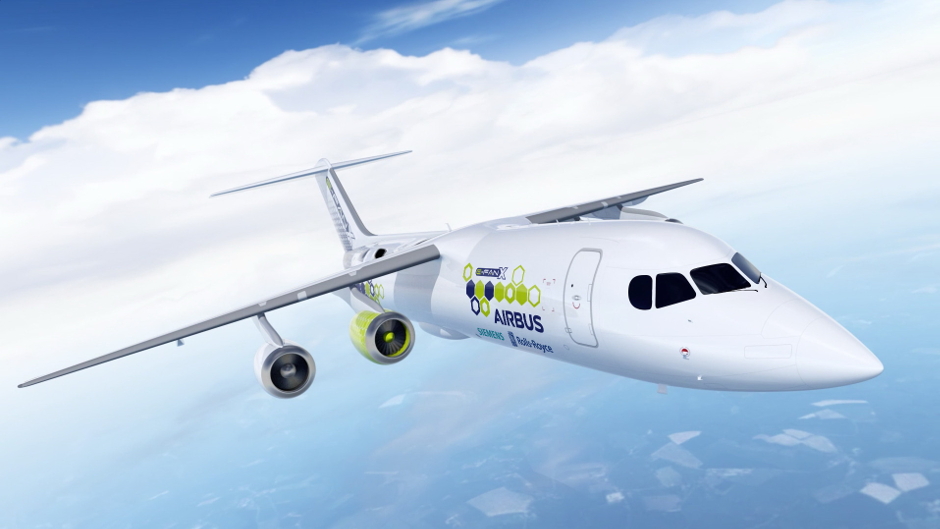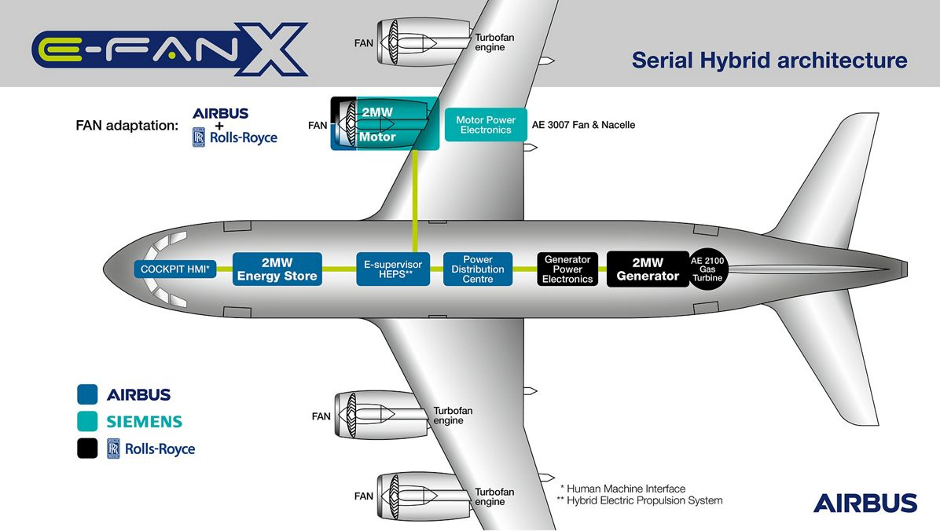
The partnership between Airbus, Rolls-Royce, and Siemens aims at developing a near-term flight demonstrator with the future potential to move regional travel from rail to air at cruising speeds that match current aircraft. The three companies announced the collaboration today, 28 November 2017, at the Royal Aeronautical Society in London.
The E-Fan X hybrid-electric technology demonstrator is anticipated to fly in 2020 following ground tests, provisionally on a BAe 146, with one of the aircraft’s four gas turbine engines replaced by a 2MW electric motor. Provisions will be made to replace a second gas turbine with an electric motor once system maturity has been proven.
“The E-Fan X is an important next step in our goal of making electric flight a reality in the foreseeable future. The lessons we learned from a long history of electric flight demonstrators, starting with the Cri-Cri, including the e-Genius, E-Star, and culminating most recently with the E-Fan 1.2, as well as the fruits of the E-Aircraft Systems House collaboration with Siemens, will pave the way to a hybrid single-aisle commercial aircraft that is safe, efficient, and cost-effective,” said Paul Eremenko, chief technology officer at Airbus. “We see hybrid-electric propulsion as a compelling technology for the future of aviation.”
The E-Fan X demonstrator will explore the challenges of high-power propulsion systems, such as thermal effects, electric thrust management, altitude and dynamic effects on electric systems and electromagnetic compatibility issues.
As part of the E-Fan X programme, Airbus will be responsible for overall integration as well as the control architecture of the hybrid-electric propulsion system and batteries, and its integration with flight controls.
Rolls-Royce will be responsible for the turbo-shaft engine, 2MW generator, and power electronics. Along with Airbus, Rolls-Royce will also work on the fan adaptation to the existing nacelle and the Siemens electric motor.
Siemens will deliver the 2MW electric motors and their power electronic control unit, plus the inverter, DC/DC converter, and power distribution system.

Paul Stein, Rolls-Royce CTO, said: “The E-Fan X enables us to build on our wealth of electrical expertise to revolutionise flight and welcome in the third generation of aviation. This is an exciting time for us as this technological advancement will result in Rolls-Royce creating the world’s most powerful flying generator.
Among the top challenges for today’s aviation sector is to move towards a means of transport with improved environmental performance, that is more efficient and less reliant on fossil fuels.
The partners say they are committed to meeting the EU technical environmental goals of the European Commission’s Flightpath 2050 Vision for Aviation (reduction of CO2 by 60%, NOx by 90%, and noise reduction by 75%, all based on 2000 levels) but the targets will be difficult to achieve with current technologies.
Electric and hybrid-electric propulsion systems are considered promising for addressing these challenges and Mark Cousin, head of demonstrators at Airbus believes double digit fuel economy savings could be made with the new configuration.




JLR teams with Allye Energy on portable battery storage
This illustrates the lengths required to operate electric vehicles in some circumstances. It is just as well few electric Range Rovers will go off...